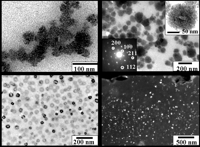
1Nanoscience Group, Materials Chemistry Division and
2Biochemical Sciences Division, National Chemical Laboratory, Pune – 411 008, India
e-mail: biovipul@yahoo.co.in

 |
Vipul Bansal1, Debabrata Rautaray1, Ambarish Sanyal1, Absar Ahmad2, and Murali Sastry1
1Nanoscience Group, Materials Chemistry Division and e-mail: biovipul@yahoo.co.in |
 |
Silica is by far the most important inorganic matrix, both for mesoporous solids and hollow microspheres. The chemical synthesis of hollow silica microspheres [1] is not only relatively expensive and eco-hazardous, but also often requires extreme conditions. In contrast, biosilicification proceeds under mild physiological conditions, producing an amazing diversity of complex and hierarchical biogenic silica nanostructural frameworks. Despite the vast scientific literature on silica synthesis by biological methods, there have been no attempts at developing a bioleaching protocol for the same. This manuscript describes our efforts to set up a model system for the extracellular bioleaching of silica nanoparticles from sand. We show that Fusarium oxysporum, a plant pathogenic fungus, when exposed to sand is capable of leaching out quasi-spherical, hollow silica nanoparticles of reasonable monodisperisty. Interestingly, despite the in vitro studies of various proteins or synthetic macromolecules in this context [2], only the F. oxysporum based system could produce the aforesaid silica structures for the conditions studied to date. These results along with our previous studies on the use of the same fungus for the biosynthesis of metal nanoparticles [3] highlights the potential of this versatile fungus in nanotechnology, particularly in the development of cheap, eco-friendly methods for large-scale synthesis of nanomaterials.